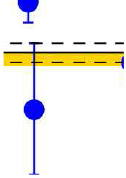The metal-poor damped Lyman alpha (DLA) system at z = 3.04984 in the QSO
SDSSJ1419+0829 has near-ideal properties for an accurate determination of the
primordial abundance of deuterium, (D/H)_p. We have analysed a high-quality
spectrum of this object with software specifically designed to deduce the best
fitting value of D/H and to assess comprehensively the random and systematic
errors affecting this determination. We find (D/H)_DLA = (2.535 ±0.05) x
10^(-5), which in turn implies Omega_b h^2 = 0.0223 ± 0.0009, in very good
agreement with Omega_b h^2 (CMB) = 0.0222 ± 0.0004 deduced from the angular
power spectrum of the cosmic microwave background. If the value in this DLA is
indeed the true (D/H)_p produced by Big-Bang nucleosynthesis (BBN), there may
be no need to invoke non-standard physics nor early astration of D to bring
together Omega_b h^2 (BBN) and Omega_b h^2 (CMB). The scatter between most of
the reported values of (D/H)_p in the literature may be due largely to
unaccounted systematic errors and biases. Further progress in this area will
require a homogeneous set of data comparable to those reported here and
analysed in a self-consistent manner. Such an endeavour, while observationally
demanding, has the potential of improving our understanding of BBN physics,
including the relevant nuclear reactions, and the subsequent processing of 4He
and 7Li through stars.
\\ ( http://arxiv.org/abs/1205.3785 , 232kb) |

![]()